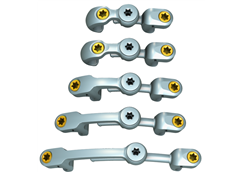For many years, surgeons have been using a Crosslink mainly to prevent rotational inestability and the “windshield wiper effect”. Quadrangulation of the spinal implants asembly has been considered necessary in the cases of great inestability and in long constructions in order too avoid mechanical complications.
Niswander and colleagues had the conclusion that there were no obvious improvement for young patients who had crosslinks compared with patients who didn’t. And they also addressed the financial issue:The discontinuation of this device use could save roughly $1,000 per surgery.In other words: Too much cost (1000$/case) for a Unexisting benefit (any improvement).
Our Comments:
1. The study found no differences in radiographic outcomes, clinical outcomes, or complication rates between groups of patients with and without the use of crosslinks.They are talking about no positive benefit but what about preventing the risk of negative outcomes as potential complications caused by inestability? Where do they place Safety or Risk coverage?
2.- The sample of 500 patients, 377 with crosslinks and 123 without crosslinks. From our point of view, the sample of patients without a DTT device is not big enough to evaluate the risk.Which are the stadistics and how many cases do you have to perform to have the “windshield wiper effect”? Maybe it did not happen in the 123 cases but what about the next ones?
3.- The cost of the Cross-Link (1000$) represents 5,5% of the average price for scoliosis surgery (18.000 $). Would you pay that amount and avoid risks? What would be the costs involved with the
complications caused by the “Windshield effect ” if it occurs.
Conclusion:
We are very respectful with the study and the authors but we do not agree with their conclusions and with their decision to avoid using Crosslinks in adolescent idiophatic scoliosis. We think that the Crosslink creates a frame that increase stability preventing the risks associated to the “windshield wiper effect”, We think that to save 5,5% of the implant costs in every procedure is at the expense of increasing risks (even if they are small).Maybe I am right or wrong, but I would pay an additional 1000$ if the scoliosis surgery patient were my daughter. What would the rest do?
 |
| CrossLinks |

If we were talking about 250$, nobody would care about it. The issue is cost related. Arguments to save money!
If the cost of crosslink was 250$, the article would be the same?
maybe someone got a degree in english literature here…good article!
What about iatrogenic effect of the crosslinks? There's a lot of cases of pseudarthrisis just in front of the crosslink due to a lack of bone graft…
The English is poor but I find the article very interesting.Congratulations!
Who wrote this article? The English is poor and the logic very hard to follow.
In one or two levels Crosslinks are not necessary but in long constructions I think it is. The study is cost reduction oriented